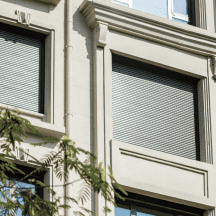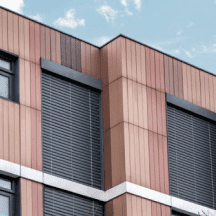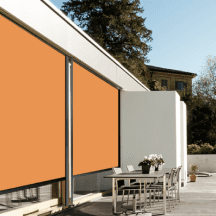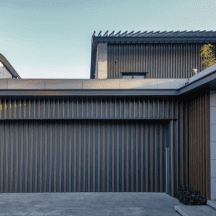MEDIA CENTER
March 30, 2023
Garage doors components
Garage doors are an essential component of any residential or commercial building. They provide security and protect the property from theft, weather elements, and damage. Garage doors come in a variety of styles and designs, and their components also vary depending on the type of door. This article will explore the different components of rolling up garage doors and sliding garage doors, along with the styles and choices available for each component.
Rolling up garage doors are one of the most popular types of garage doors. They are easy to operate, require minimal space, and provide excellent security. The following are the main components of rolling up garage doors:
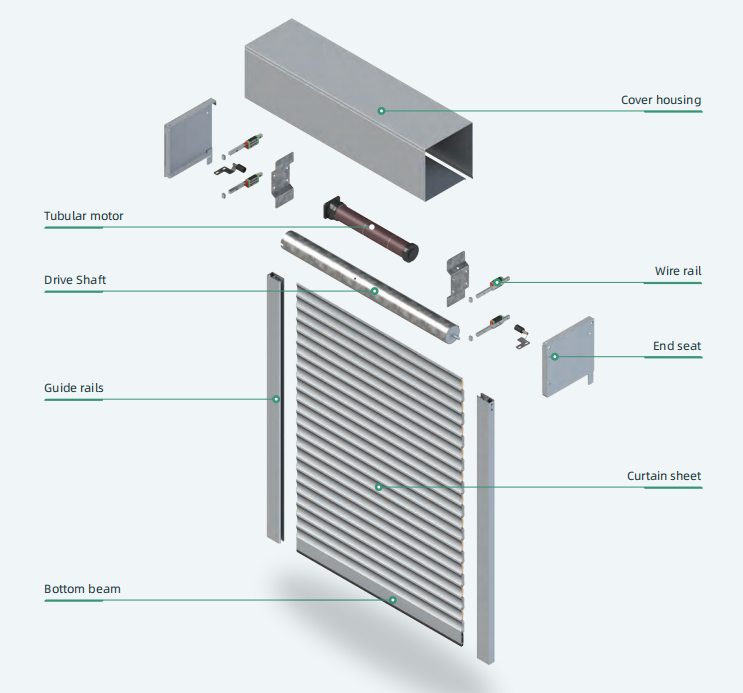
Rolling garage doors structure of ULE PANDA shutters
Cover housing
The “cover housing” is commonly known as “roll-formed aluminum covers” or “aluminum coil covers”. These covers are typically made up of two panels of aluminum that are roll-formed to create a protective box for the roller garage door slats.
The purpose of the cover box is to protect the garage door slats from damage and the elements. The cover box also helps to keep the garage door track clean and free of debris, which can prevent the door from functioning correctly.
Roll-formed aluminum covers are available in various colors and finishes to match the aesthetic of the garage door and the surrounding architecture. They can also be customized to fit specific garage door sizes and configurations.
Tubular motor
A tubular motor is a type of electric motor that is commonly used in rolling garage doors. It is called a “tubular” motor because the motor itself is shaped like a tube or cylinder.
The motor is typically installed within the door itself, inside a metal tube that runs horizontally across the top of the garage opening. The motor is connected to a driveshaft that runs the length of the tube. The driveshaft is attached to the door’s curtain or slats, which roll up and down along tracks on either side of the door.
When the motor is activated, the driveshaft rotates, which in turn causes the door to roll up or down. The speed and direction of the motor can be controlled by a remote control or a wall-mounted switch.
Tubular motors are preferred for rolling garage doors because they are compact, efficient, and easy to install. They are also quiet and reliable, and they can be adapted to work with a variety of door sizes and styles. Overall, they provide a convenient and effective solution for opening and closing garage doors.
drive shaft
The drive shaft is a component of a rolling garage door that is responsible for transmitting power from the motor to the door curtain sheet, causing the door to open and close.
The drive shaft is typically made of steel and is supported by bearings at either end. It runs horizontally across the top of the garage opening and is connected to the door curtain sheet with a series of chains or belts.
When the motor is activated, it rotates the drive shaft, which in turn rotates the chains or belts, causing the door curtain sheet to roll up or down along the guide rails. The speed and direction of the door are controlled by the motor, which may be operated with a remote control, wall switch, or other control devices.
Proper installation and maintenance of the drive shaft are important for ensuring the smooth and reliable operation of a rolling garage door. Over time, the drive shaft may become worn or damaged, which can affect the door’s movement and compromise its safety. Regular inspection and lubrication of the drive shaft and bearings can help to extend its lifespan and ensure that the door operates safely and efficiently.
guide rails
Guide rails, also known as track or channels, are an essential component of a rolling garage door system. They are typically made of metal and run vertically on either side of the garage opening, providing a smooth and stable track for the door to roll up and down.
The guide rails are fixed to the garage walls, and the door’s slats or curtain roll up and down between them. The rails are designed to keep the door aligned and prevent it from rubbing against the sides of the opening, which can cause damage and impede the door’s movement.
Guide rails come in a variety of shapes and sizes to suit different types of doors, from single-panel garage doors to multi-panel sectional doors. They are often made of galvanized steel, which is resistant to rust and corrosion, and they may have additional features such as weatherstripping to help seal out drafts and prevent energy loss.
Proper installation and maintenance of guide rails are crucial to ensuring the smooth and reliable operation of a rolling garage door. Over time, the rails may become misaligned or damaged, which can affect the door’s movement and compromise its security. Regular inspection and repair can help extend the life of the door and keep it functioning properly.
curtain sheet
The curtain sheet, also known as the door curtain, is the main component of a rolling garage door that provides the physical barrier between the garage interior and the outside environment. It is made up of a series of interlocking metal slats or panels that roll up and down along the guide rails on either side of the garage opening.
The slats are typically made of steel or aluminum, and they are connected to each other with hinges or flexible joints. The slats are designed to interlock with each other when the door is closed, creating a solid and secure barrier. When the door is opened, the slats roll up tightly into a compact coil at the top of the garage opening, maximizing the available space.
Curtain sheets are available in a variety of thicknesses, colors, and finishes to suit different applications and aesthetic preferences. Thicker slats provide greater durability and security, while lighter-weight slats may be suitable for residential applications where energy efficiency and ease of use are more important.
In addition to providing security and weather protection, curtain sheets may also incorporate additional features such as insulation, soundproofing, and fire resistance. Proper maintenance of the curtain sheet, including regular cleaning and lubrication of the slats and tracks, is important for ensuring the smooth and reliable operation of a rolling garage door.
bottom beam
The bottom beam, also known as the bottom bar, is an important component of a rolling garage door. It is the horizontal bar that runs along the bottom edge of the curtain sheet and holds the slats in place.
The bottom beam is typically made of steel or aluminum and is designed to be strong and durable, as it bears the weight of the entire door when it is closed. The bottom beam is attached to the slats with brackets or clips, which allow the slats to pivot freely as the door rolls up and down.
The bottom beam also serves as a barrier to prevent intruders from lifting the door from the bottom and gaining access to the garage. Some bottom beams are designed to include weatherstripping to help seal the gap between the door and the garage floor, preventing drafts and energy loss.
Proper installation and maintenance of the bottom beam are important for ensuring the smooth and reliable operation of a rolling garage door. Over time, the bottom beam may become damaged or corroded, which can affect the door’s movement and compromise its security. Regular inspection and repair can help extend the life of the door and keep it functioning properly.
Weatherstripping
Weatherstripping is an important component of a rolling garage door that helps to seal the gap between the door and the frame, preventing drafts, dust, and moisture from entering the garage.
Weatherstripping is typically made of a flexible material, such as rubber or PVC, and is attached to the edges of the door curtain sheet. When the door is closed, the weatherstripping compresses against the frame, creating a tight seal that prevents air and moisture from passing through.
Weatherstripping comes in a variety of shapes and sizes to suit different types of doors and frames. Some types of weatherstripping are designed to be self-adhesive, while others are attached with screws or clips.
Proper installation and maintenance of weatherstripping are important for ensuring its effectiveness. Over time, weatherstripping may become worn or damaged, which can compromise its sealing properties. Regular inspection and replacement of weatherstripping can help to ensure that the garage remains properly sealed and protected from the elements.
Sliding garage doors are another popular type of garage door. They slide horizontally along tracks and are ideal for garages with limited headroom. The following are the main components of sliding garage doors:

sliding garage doors structure of ULE PANDA shutters
Top rails
The top rails are an important component of a side sliding garage door system. They are horizontal tracks or rails that are installed at the top of the garage opening, and they guide the door panels as they slide open and close.
The top rails are typically made of steel or aluminum and are secured to the ceiling or walls of the garage with brackets or other hardware. The door panels are attached to the top rails with rollers or trolleys that allow them to slide smoothly along the tracks.
Proper installation and maintenance of the top rails are important for ensuring the smooth and reliable operation of a side sliding garage door. Over time, the top rails may become worn or damaged, which can affect the door’s movement and compromise its safety. Regular inspection and lubrication of the top rails and rollers can help to extend their lifespan and ensure that the door operates safely and efficiently.
It’s worth noting that the top rails are just one component of a side sliding garage door system. The system may also include bottom rails or tracks, side frames or jambs, and other hardware components that work together to ensure the door operates smoothly and securely.
motor
The motor is a key component of a side sliding garage door system that provides the power to open and close the door. The motor is typically located at one end of the top rail and is connected to the door panels via a chain, belt, or gear mechanism.
When activated by a remote control, wall switch, or other control devices, the motor rotates a gear or pulley, which moves the chain or belt and pulls the door panels along the top rail. Some motors may have adjustable speed settings, allowing the user to control the speed at which the door opens and closes.
The motor in a side sliding garage door is usually an electric motor that is designed to be durable and long-lasting. It may have built-in safety features, such as an automatic stop and reverse mechanism that will cause the door to stop and reverse direction if it encounters an obstacle while closing.
Proper installation and maintenance of the motor are important for ensuring the smooth and reliable operation of a side sliding garage door. Regular inspection and lubrication of the motor and its components can help to extend its lifespan and ensure that the door operates safely and efficiently. If any issues arise with the motor or the door system, it is recommended to seek the assistance of a qualified technician to diagnose and repair the problem.
manual unlocking rope
The manual unlocking rope is a safety feature that is included in some side sliding garage door systems. It is designed to allow the door to be manually operated in the event of a power failure or other emergency situation.
The manual unlocking rope is typically a cord or rope that is attached to the door panels and runs along the inside of the garage to a release mechanism located near the motor or in another accessible location. When pulled, the release mechanism disengages the motor and allows the door to be manually opened or closed by pulling on the rope.
It’s important to note that the manual unlocking rope should only be used in emergency situations, as using it to open or close the door regularly can cause wear and tear on the system and may compromise its safety.
Proper installation and maintenance of the manual unlocking rope are important for ensuring that it functions properly in the event of an emergency. It is recommended to periodically check the rope for any signs of wear or damage and to ensure that the release mechanism is easily accessible and functioning correctly. If any issues arise, it is recommended to seek the assistance of a qualified technician to diagnose and repair the problem.
curtain sheet
The curtain sheet is a key component of a side sliding garage door system. It is the main section of the door that slides along the top rails to open and close the garage opening.
The curtain sheet is typically made of a sturdy material such as aluminum, steel or vinyl, and may be insulated to provide thermal protection and noise reduction. The sheet may also be reinforced with struts or ribs to provide additional strength and stability.
The curtain sheet is attached to the door panels which slide along the top rails. The door panels may be equipped with rollers or trolleys that allow them to slide smoothly along the tracks. The bottom of the curtain sheet may be weighted or attached to a bottom rail to provide stability and prevent the sheet from sagging or flapping in the wind.
Proper installation and maintenance of the curtain sheet are important for ensuring the smooth and reliable operation of a side sliding garage door. Over time, the sheet may become worn or damaged, which can affect the door’s movement and compromise its safety. Regular inspection of the curtain sheet and its components can help to identify any issues and prevent costly repairs down the line.
bottom wheel
The bottom wheel is an essential component of a side sliding garage door system. It is located at the bottom of the door panel and is responsible for guiding the door along the bottom rail or track.
The bottom wheel typically consists of a wheel or set of wheels that are mounted on an axle or spindle. The wheel may be made of various materials such as plastic or steel, and may be designed with a tread or groove to help it grip the bottom rail or track.
The bottom wheel is attached to the bottom of the door panel and is designed to roll along the bottom rail or track as the door is opened and closed. Some bottom wheels may be adjustable or spring-loaded to allow for smoother operation and to compensate for any unevenness or irregularities in the surface of the bottom rail or track.
Proper installation and maintenance of the bottom wheel are important for ensuring the smooth and reliable operation of a side sliding garage door. Over time, the wheel may become worn or damaged, which can affect the door’s movement and compromise its safety. Regular inspection and lubrication of the bottom wheel and its components can help to extend its lifespan and ensure that the door operates safely and efficiently. If any issues arise with the bottom wheel or the door system, it is recommended to seek the assistance of a qualified technician to diagnose and repair the problem.
floor rails
Floor rails, also known as bottom tracks or guides, are an important component of a side sliding garage door system. They are typically mounted on the floor of the garage and provide a smooth and stable track for the bottom wheels of the door panels to slide along.
Floor rails are typically made of a sturdy material such as steel or aluminum and are designed to withstand the weight and movement of the door panels. They may be coated with a corrosion-resistant material to protect against rust and wear.
Floor rails are typically installed in pairs, with one rail positioned on each side of the garage opening. They are attached to the floor using screws or bolts and may be leveled or adjusted to ensure a smooth and level surface for the bottom wheels of the door panels to slide along.
Proper installation and maintenance of the floor rails are important for ensuring the smooth and reliable operation of a side sliding garage door. Over time, the rails may become worn or damaged, which can affect the door’s movement and compromise its safety. Regular inspection and cleaning of the floor rails can help to prevent the buildup of debris or dirt that can interfere with the movement of the door panels. If any issues arise with the floor rails or the door system, it is recommended to seek the assistance of a qualified technician to diagnose and repair the problem.
Conclusion
Garage doors are an essential component of any building. Rolling up garage doors and sliding garage doors are two popular types of garage doors, each with its components and styles. The components of rolling up garage doors include tracks, springs, rollers, hinges, and weatherstripping. The components of sliding garage doors include tracks, rollers, and locks. Garage doors also come in different styles and designs, such as raised panels, recessed panels, flush panels, and carriage houses. The materials used for garage doors include steel, aluminum, wood, and fiberglass. Understanding the different components and styles of garage doors can help homeowners make informed decisions when choosing a garage door for their property.
Contact us

Kevin
Account Manager

info@ulepanda.com

+86 18551587339

+86 18551587339


